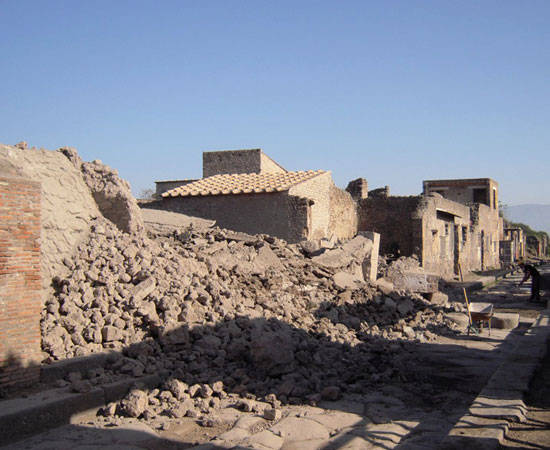Vandals – The Assault to Italy’s Beauties
On September 29th, at the Italian Cultural Institute, journalist Gian Antonio Stella presented his latest work “Vandals – The assault to Italy’s beauties,” a compelling investigation of the condition of the Italian artistic heritage. The author analyzes with co-author Sergio Rizzo the causes of its decay and presents alarming figures on the phenomenon, which has only been timidly tackled, when it hasn’t been guiltily underestimated or ignored, by the Italian institutions.
Exhibit A is the case of the Appia Antica, the historical trait of the Appian consular road in Rome, built in 312 BC. The road is closed to the traffic, but “Auto Blu”, the blue cars that Italian politicians are escorted with, are free to circulate on it in case the queues on the regular routes to reach Ciampino Airport are too long. Generally, they are.
Italy has more UNESCO World Heritage Sites than any other nation in the world. They amount to 45. The US possess 21, Great Britain 28, Germany has 33, France 35, China 40, Spain 42.
Italy, though, is also the nation that makes the least profits of all out of her World Heritage Sites. China, for instance, earns from her Sites around 3 times the amount of money Italy does.
The most infuriating comparison, however, is the cost of the Italian Members’ of Parliament life annuities, amounting to 198 million Euros per year, and the annual revenue from all the museums and archaeological sites on the Italian territory, totaling to 82 million Euros (figures estimated in 2009).
Most Italians probably wouldn’t guess that, but President Barack Obama’s monthly salary amounts to 3,000 Euros less than the one of Luis Durwalder, Governor of the Bolzano Province in the small Trentino Alto-Adige region, who earns 26,000 Euros a month.
Italy overpays politicians and invests less and less on culture and research, as the halving of the government funding registered over the last ten years demonstrates (from 2386 million Euros in 2001, to 1429 million Euros in 2011, Stella reports). All the while, electoral campaign refunds have grown 1100%, with a vertiginous increase of public money expenditure.
When it comes to artistic heritage preservation policies, Stella provides evidence of Italian politicians wasting public money on spotty interventions without a long-term plan for the cherishing of the country’s beauties, which could also play a determinant role in the growth of the Italian GDP. The contribution of the tourism sector to Italy’s GDP is 5,68%, whereas for countries such as Turkey, Portugal and Spain it is about 20%.
In the 1970s, Italy was the first touristic destination for international travelers. It now ranks 5th place after France, Spain, USA and China. Why is that?
Stella believes it’s because Italy lacks some of the basic infrastructures that would facilitate traveling and make an Italian holiday truly enjoyable for tourists. The public transportations system needs improvements, and so does the country’s connectivity: more wi-fi, please.
But what Stella and Rizzo are most worried about, and they point it out with their book, is the loss of the “sense of beauty” among Italians, as Stella puts it in his presentation at the ICI. This pairs with a general lack of patriotism/civic pride. Symbols of the Italian Renaissance such as the Citadel of Alessandria, in Piedmont, where the first patriots fought for independence, is abandoned and decaying, notwithstanding the appointment as UNESCO World Heritage Site. So is Scipio’s Tomb in Campania – a balcony was built on top of it – and so was Cavour’s Villa in Torino Vercellese, which, luckily, has started being restored a month ago.
Cavour, whom Stella defined as the “Italian Jefferson,” is represented in the Villa by a beheaded statue. Stella expressed his disappointment with an Italian law approved in 2004 restricting prosecutions on art traffickers: even if the stolen head was found, the possessor couldn’t be arrested because it would be impossible to prove it was him who beheaded the work of art. The same thing has happened to the amateur archaeologists who in 2008 exhumed the Muses Sarcophagus in Ostia Antica: they were ready to chop it in parts with a jack to sell the muses individually on the international black market of artworks, and they couldn’t be jailed. The current Minister of Cultural Heritage Giancarlo Galan promised to have the law modified, Stella added.
As Marquis De Sade wrote in his “Travel in Italy” in 1775, “Why do the Heavens send such a treasure to people who are not able to appreciate it?”
Stella replies: “For many years Italians thought that being ‘masters in their own home’ meant that they could do whatever they pleased with their country, and many of them did: today there are 4,400,000 illegal structures in Italy,” which means that one in six Italians (roughly 10 million Italians), live or spend their holidays in one of the over 4 million illegal structures. “It is inacceptable,” he tells i-Italy.
And when Italian politicians are too busy arguing about the worthiness of spending “all that money for those four rocks in Pompeii,” as the President of Veneto region Luca Zaia affirmed in November 2010, when three buildings in the archaeological site collapsed, it is impressive how dedicated and compelled the international admirers of the Italian beauties are to preserving them.
“Save Venice”, represented at the book launch by head of the Venice office Melissa Conn, is an American organization founded in 1968 for the defense of Venice’s artistic heritage, with over 400 restoration projects running in 75 locations. “It represents an amazing example of cooperation between the American private sector and the Italian institutions,” Conn says.
With Conn, Stella affirms that a positive counter-trend in the Italian attitude towards these problems is detectable. Something is changing for the better.
“There is much more sensitivity to these issues nowadays,” he tells i-Italy, and plenty of success stories of monument-rescuing are addressed by the journalist during his presentation: one for all, the wondrous restoration of the Venaria Reale palace in Piedmont, completed in less than ten years (under both right-wing and left-wing governments) and now open to the public.
To those who criticize Stella and Rizzo’s work for depicting an over-dramatic image of the state of the art (pun intended) in Italy, he replies through i-Italy: “If your woman cheats on you and you love her, that’s when you get furious. Sergio Rizzo and I are deeply in love with Italy. That’s why we write these books.”





































i-Italy
Facebook
Google+
This work may not be reproduced, in whole or in part, without prior written permission.
Questo lavoro non può essere riprodotto, in tutto o in parte, senza permesso scritto.